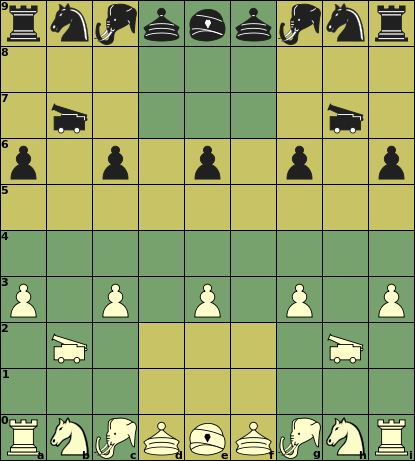Xiangqi (Chinese Chess)
Xiangqi is the World's number one Chess variant in terms of number of players. Almost all players live in China, Taiwan or Vietnam, though. It is a fast and aggressive game, often described as a 'race to mate'. When it gets to an end-game it is often a draw, because there are many pieces that cannot leave their own board half, and thus can be used to defend but not to attack or to trade for the opponent's defenders.
 |
Initial setupe0, e9: King |
Moves at a Glance
Click on a white piece below to see its moves
 |
 |
Sliding capture or non-capture, can be blocked on any square along the ray |
|||||||||
 |
Non-capture only | ||||||||||
 |
 |
Capture only | |||||||||
 |
 |
 |
 |
 |
Unreachable square where move to other square can be blocked | ||||||
 |
 |
||||||||||
 |
 |
 |
|||||||||
:
:
:
:
| Piece | ID | value | Moves (Betza notation) | Remarks |
| King | K | - | W | Cannot leave its Palace |
| Rook | R | 10 | R | |
| Cannon | C | 4-5 | pR | Must jump 1 piece to capture |
| Horse | H | 5-4 | n[WF] | Cannot jump |
| Adviser | A | 2 | F | |
| Elephant | E | 2 | nA | Cannot move onto opponent's board half |
| Pawn | P | 1 | fW | Acquires sideway moves (fWsW) on opponent's board half |
Pawn peculiarities
- Pawns capture and move straight ahead.
- When they reach the opponent's board half ('cross the River'), they can also move and capture sideways.
- There is no real promotion; when Pawns reach last rank they are stuck there.
General rules
- It is not allowed to expose your King to check.
- Kings are not allowed to face each other, i.e. be on the same file with nothing in between.
- The game is won by checkmating the opponent's King.
- Stalemate (no legal moves, but not in check) is a los for the stalemated side.
- Perpetual checking is forbidden, and the side that checks is ruled to lose on the 3rd repeat.
- When both sides are perpetually checking each other, the game is ruled a draw, however.
- It is also forbidden to perpetually harass the same piece other than King (see below).
- But when both sides do it, the game is again ruled a draw.
Differences with FIDE
The board is sub-divided into zones, and some pieces are not allowed to cross some zone boundaries. Pieces move in general different than their FIDE counterpart. Only the Rook moves truly the same.
Perpetual Chasing
It is forbidden to perpetually harass the same piece, and when a repeat loop (after 3 repeats) has one side violating this rule, that side will forfeit the game. This is only invoked if there wasn't any perpetual checking in the loop as well. Exact rules for this are quite complex. Basically, when a repeat loop creates a new attack on the same unprotected piece on every move, the move sequence will be considered a perpetual chase. The chasing side then is ruled to lose, but if both sides are chasing, it is a draw. A Rook counts as unprotected against attacks of C or H. On the other hand, being able to capture your attacker (as when equal pieces attack each other) counts as (pre-emptive) protection. Attacks on a Pawn that is still on its own board half, or attacks by a King are never considered chases.
Only legal moves should be taken into account; i.e. pinned pieces are not considered attackers or protectors. An attack by the same piece is not considered a new one just because the attacking piece moved to another location, e.g. when a Rook moves along the ray of the attack. Note that the above rules do not take into account whether the attacking or protecting captures are good or non-sensical, or if pieces are sufficiently protected against multiple attacks. Even if recapturing would get you mated in one, the piece would still count as protected! Also note that is perfectly allowed to alternately chase different pieces. Even if one of the pieces is a King.
Strategy issues
Any piece except a Pawn on the last rank can force Checkmate against a bare King.